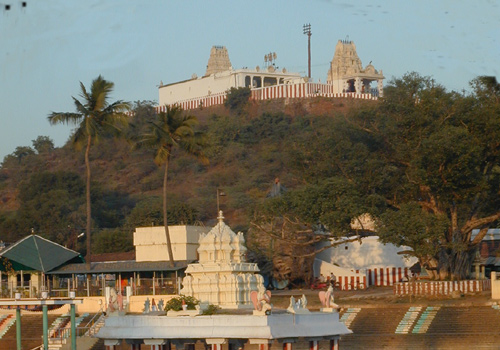Thiruneermalai Sree Ranganathaswami Temple, One of the 2000 Years Old Prarthana Sthalam especially for marriage is located in Chennai, which is also being worshipped as Thothadri means Hillock surrounded by water.
Thotha means water and Adhri means Hill hillock. As the ALMIGHTY is blessing in a hillock surrounded by water, the temple is being worshipped as Thiruneermalai. In Tamil Thiru means ALMIGHTY Neer means Water and Malai means Hillock hence Thiruneermalai.
It?s the One and Only Divyadesam where the ALMIGHTY is Blessing in HIS all four Forms Standing, Walking, Sitting and Sleeping Postures. ( Azhwar praises asNindran, Nadanthan, Irunthan and Kidanthan) Thirumangai Azhwar refers this Thiruneermalai to four other Divya Desams which are Thirukkovilur, Thiruvali, Thirunaraiyur Koil and Thirukkudanthai while showering his praises on Thiru Neermalai Divyadesam.
This is a hill temple. There are two big temples both at the top and the foot hill. Lord appears in four forms representing three incarnations of Lord Vishnu. The temple has a beautiful Teppakulam-tank covering three acres with a Mandap at the centre.
Moolavar - Thiruneervannan, Neelmugilvannan
Utsavar - Neelmighilvannan
Thayar - Animaamalarmangai Nachiyar
Posture - Standing Posture Facing East
Vimanam - Thoyagiri Vimanam
Kshetram - Thoyadhri Kshetram
Pushkarini - Manikarniga Theertham, Ksheera Pushkarini
Ranganatha Temple is a Hindu temple in Thiruneermalai, a suburb of Chennai, India. While the Sthalathipadi (presiding deity) is Neervanna Perumal, all utsavams (Celebrations) are for Lord Ranganatha.
The complex in in two parts one at the base of the hill for the Staladhipadhi Neervanan (Ninran-Standing Posture), housing shrines of his consort Animamalar Mangai thayar, Kalyana Ramar and Andal. Shrine for Anjaneya (Hanuman) is to the right as one climbs up to the hill shrine.
The temple complex up the hill has three shrines for Lord Ranganatha (Kidanthaan in reclining posture), Trivikrama (Nadanthaan in walking posture), Lord Narasimha (Irundhaan - sitting posture) and a Shrine for Ranaganayaki Thayar (facing East). It is a double prakaram (outer courtyard) temple.
The Garuda shrine faces the Lord. The view from the top of the hill is wonderful.Two Bramhotsavams and Uttiram (Birth star of mother goddess) are celebrated. Bramhotsavam of Neervanan is held in the Tamil month of Panguni (mid March - mid April) and for Rangantha Perumal in the month of Chittirai (mid April - mid May).
While Panguni uttiram is celebrated for Ranganayaki Thayar, Masi Uttiram is the Birth star of Animamalar Mangai, the consort of Neervanna Perumal.
Tiruneermalai Neervanna Perumal temple is one among the 108 Divya Desas of Perumal. Lord appears in four postures. Narasimha blesses here as Lord Bala Narasimha.
It is said that once Thirumangai Alwar came here to get the Dharshan
of the Perumal. At that time, the mountain was fully surrounded by water
and he waited for six months to worship the Perumal. After all the
water drained, he went up the mountain and worshipped the Perumal. The
place where Thirumangai Alwar stayed is called as "Thiru Mangai
Alwarpuram".
Do:
- Do pray your Ishta Devata before pilgrimage to Temple.
- Do contact Temple Devasthanam information centre for enquiry, temple information and for Pooja details etc.
- Do reserve your travel and accommodation at Temple well in advance.
- Do bath and wear clean clothes before you enter the temple.
- Do concentrate on God and Goddess inside the temple.
- Do maintain silence and recite your Istamantram to yourself inside the temple.
- Do observe ancient custom and traditions while in Temple.
- Do respect religious sentiments at Temple.
- Do deposit your offerings in the hundi only.
Don't s:
- Do not come to Temple for any purpose other than worshipping of God and Goddess.
- Do not smoke at Temple.
- Do not consume alcoholic drinks at Temple.
- Do not eat non-vegetarian food in the Kshetram.
- Do not approach mediators for quick Darshanam. It may cause inconvenient to others.
- Do not carry any weapon inside the temple.
- Do not wear any head guards like helmets, caps, turbans and hats inside the temple premises.
- Do not perform Sastanga Pranama inside the Sanctum Sanctorum.
- Do not take much time while performing Sparsa Darshanam to God in Garbhagriha.
- Do not buy spurious prasadams from street vendors.
- Do not encourage beggars at Temple.
- Do not spit or create nuisance in the premises of the temple.
